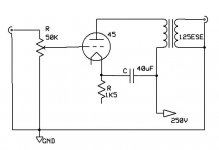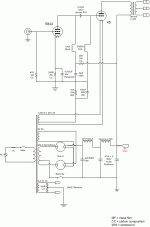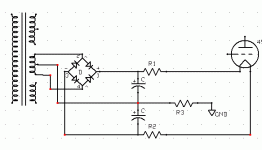I am looking into building a headphone amp based upon jack elliano's ultrapath design. (here's a link to a schematic http://www.electra-print.com/ultrapath.html ) I am considering one of the above tubes and thought I'd ellicit people's impressions about the relative merits of each. Yes, I know ths is probably over the top, but since the Cary 300SEI is the only headphone amp that has ever really done it for me, I think this may be the right way to go. Any thoughts or other candidates?
-d
-d
each of those tubes has a different character, so it will be difficult to answer what *you* will like.
As for me, I made a simple 2A3 headphone amp, that doubles as a power amp and I like it. However, I can't lug it along, so I end up with my CMoy most of the time.
In the near future, I'd like to build a 12B4 head amp, so I can bring it to the office...
Cheers!
As for me, I made a simple 2A3 headphone amp, that doubles as a power amp and I like it. However, I can't lug it along, so I end up with my CMoy most of the time.
In the near future, I'd like to build a 12B4 head amp, so I can bring it to the office...
Cheers!
I guess this is really the question here. I am looking for vague descriptions of the character of these tubes to help decide which to design around. I have 300b based power amps, so I have a sense of what those are like, but I am not familiar with the others. What I am looking for is something full and lush and warm.arnoldc said:each of those tubes has a different character, so it will be difficult to answer what *you* will like.
I'd be curious to see more of your design.arnoldc said:As for me, I made a simple 2A3 headphone amp, that doubles as a power amp and I like it.
Everytime I think I am starting to understand something about this stuff, I am invariably knocked down a few pegs. My understanding, however, was that so long as the voltage is where it should be, that the phones would control how much current is drawn. I know that lots of other headphone amps can put out a watt or two, yet people still seem to use them for headphones, but perhaps there is just a step here that I don't understand. As for the Cary, I guess I don't really know how they do it. I assumed there would be an appropriate tap to the ouput transformers, but maybe not? Maybe they just use a resistor divider?astouffer said:Any one of those tubes will output over a watt and blow the headphones off your head. Maybe look into parafeed for the output transformer. How does the Cary amp drive headphones?
dsavitsk, i won't be able to describe it based on a headphone amp, but as an amp 
205 - never got to own one
2A3 - for me is general purpose, from classical to heavy metal which is my music preference, can be fast and furious;
45 - for me this is more suited for vocals, i.e. astrud gilberto;
i made a quick and dirty 2A3 head amp for my Philips SBC HP-890 can which is 32 ohms, and while i draw it up a gain, let me just describe it to you...
PSU is using 1N5408 - 470uF - 5H choke - 470uF to put out around 300V B+ for the 2A3 and 150R - 47uF going to the 12AX7.
driver is a simple textbook 12AX7 (i need gain!! i need small tube!!) Rk=1K, plate R = 220K, cap coupled via Auricap 0.22uF to 2A3 with Rk=880R, OPT is custom-wound with 16 ohm tap, and this is where I get the headphone output. When the headphone is engaged, it is paralleled with a 15R resistor (because I'm lazy!)
the 2A3 filaments are DC but the 12AX7 is not.
though not perfect and may have many faults (choice of driver, use of normal OPT, etc), it sounds good enough to me.
ps.
there's an ALPS blue in front, and i use Sovtek 2A3 (my RCA 2A3 is on my main 2A3 amp)
205 - never got to own one
2A3 - for me is general purpose, from classical to heavy metal which is my music preference, can be fast and furious;
45 - for me this is more suited for vocals, i.e. astrud gilberto;
i made a quick and dirty 2A3 head amp for my Philips SBC HP-890 can which is 32 ohms, and while i draw it up a gain, let me just describe it to you...
PSU is using 1N5408 - 470uF - 5H choke - 470uF to put out around 300V B+ for the 2A3 and 150R - 47uF going to the 12AX7.
driver is a simple textbook 12AX7 (i need gain!! i need small tube!!) Rk=1K, plate R = 220K, cap coupled via Auricap 0.22uF to 2A3 with Rk=880R, OPT is custom-wound with 16 ohm tap, and this is where I get the headphone output. When the headphone is engaged, it is paralleled with a 15R resistor (because I'm lazy!)
the 2A3 filaments are DC but the 12AX7 is not.
though not perfect and may have many faults (choice of driver, use of normal OPT, etc), it sounds good enough to me.
ps.
there's an ALPS blue in front, and i use Sovtek 2A3 (my RCA 2A3 is on my main 2A3 amp)
I have built a lot of amps, and I have used all of these tubes except the 205-D (you can't get those cheap). I can't tell you what to build but I can offer some suggestions. Each of these tubes do indeed have their own character, and you should choose the one that suits your tastes. The character of each tube through headphones will be similar to the character of each tube through speakers. If you choose a tube based on the sound through speakers, use the same speakers to audition each tube. Since any of these tubes has enough power to "blow the headphoned off of your head", don't let power be a factor in your choice. My choice of these would be the 45, but that is just my preference.
Most amps use a resistor divider to drive the headphones. The reasons for this are many. The non obvious one is the fact that headphones couple directly to your head therefore they are real efficient compared to speakers. This sensitivity lets you hear all of the detail in the music AND all of the flaws in the amp. If there is any hum or microphony in the amp (inaudible with speakers) it would be loud if the phones were connected directly to the amp. The resistive divider reduces the sensitivity by about 10db.
With that thought in mind, the amp must be designed to eliminate as much hum as possible. In most cases this means DC heaters.
Full, lush and warm, that kind of describes the 2A3.
Most amps use a resistor divider to drive the headphones. The reasons for this are many. The non obvious one is the fact that headphones couple directly to your head therefore they are real efficient compared to speakers. This sensitivity lets you hear all of the detail in the music AND all of the flaws in the amp. If there is any hum or microphony in the amp (inaudible with speakers) it would be loud if the phones were connected directly to the amp. The resistive divider reduces the sensitivity by about 10db.
With that thought in mind, the amp must be designed to eliminate as much hum as possible. In most cases this means DC heaters.
Full, lush and warm, that kind of describes the 2A3.
Thanks for all the suggestions.
I am thinking that I nmight try 45's as it seems that with a little lookng and a little luck one can find them for not too much money. If I like them, I'll buy some fancier ones later.
That said, I am thinking that to start I might pick up a pair of the hammond 125xSE output transformers. They are about $65 per pair and have a 32ohm secondary tap to boot. If this experiment works, I can upgrade the iron and the tubes later. So, can anyone tell me whether I want the A, B, C, D, or E version of the transformer?
I am thinking that I nmight try 45's as it seems that with a little lookng and a little luck one can find them for not too much money. If I like them, I'll buy some fancier ones later.
That said, I am thinking that to start I might pick up a pair of the hammond 125xSE output transformers. They are about $65 per pair and have a 32ohm secondary tap to boot. If this experiment works, I can upgrade the iron and the tubes later. So, can anyone tell me whether I want the A, B, C, D, or E version of the transformer?
Just from a sense of curiosity (my tube-rolling days are well behind me) has anyone considered a cathode follower to drive headphones? You'd take a real hit on the output gain, of coruse, but since you don't need much more than a few milliwatts that needn't be a problem.
Comments?
Comments?
no driver stage? the mu (gain) of the 45 is just around 4.
if you're going for cathode bias, you'll be working around 45 volts or so bias, and your B+ needs to be 45V + 275V (plate voltage max) + ?V transformer loss (Maybe around 7V for the 125ESE) so you need around 324V B+ voltage.
you'll need a driver that can swing enough voltage to drive the 45- you have various options depending on how much gain you'll need.
you have several options for the heater configuration, but in my 45 amp i use 1.25-0-1.25V filament transformer. 1.25V goes to each filament pins and the 0 is where i connect the cathode resistor (1k5 wirewound, from RS Components) to ground bypassed with film (preferred by many) or Black Gate which i use, but not many are a fan of.
You'll notice that I plate loaded the 417/5842 and used grid choke on the 45. You can have resistors here as plate load for the 417/5842 (I originally used 10K) and grid leak for the 45 (I used 220K before using the choke).
if you're going for cathode bias, you'll be working around 45 volts or so bias, and your B+ needs to be 45V + 275V (plate voltage max) + ?V transformer loss (Maybe around 7V for the 125ESE) so you need around 324V B+ voltage.
you'll need a driver that can swing enough voltage to drive the 45- you have various options depending on how much gain you'll need.
you have several options for the heater configuration, but in my 45 amp i use 1.25-0-1.25V filament transformer. 1.25V goes to each filament pins and the 0 is where i connect the cathode resistor (1k5 wirewound, from RS Components) to ground bypassed with film (preferred by many) or Black Gate which i use, but not many are a fan of.
You'll notice that I plate loaded the 417/5842 and used grid choke on the 45. You can have resistors here as plate load for the 417/5842 (I originally used 10K) and grid leak for the 45 (I used 220K before using the choke).
Attachments
arnoldc said:no driver stage? the mu (gain) of the 45 is just around 4.
Nope, no driver stage. A gain of 4 is more than enough for a headphone or a line amp.
arnoldc said:if you're going for cathode bias, you'll be working around 45 volts or so bias, and your B+ needs to be 45V + 275V (plate voltage max) + ?V transformer loss (Maybe around 7V for the 125ESE) so you need around 324V B+ voltage.
Damn, I knew something didn't look right. So B+ should be more like 285V.
arnoldc said:you have several options for the heater configuration, but in my 45 amp i use 1.25-0-1.25V filament transformer. 1.25V goes to each filament pins and the 0 is where i connect the cathode resistor (1k5 wirewound, from RS Components) to ground bypassed with film (preferred by many) or Black Gate which i use, but not many are a fan of.
No cathode bypass in the ultrapath design either (except for the ultracap.) Also, the heater needs to be DC here to get rid of hum. The ultrapath design is a bit notorious for hum, so this needs ot be filtered and refiltered and perhaps regulated. But, if I can just do a +/- supply with the cathode resistor from the 0 between them to ground, that seems straight forward enough. That actually seems like a really good way to do it.
-d
I built one along the lines of Jack's ultrapath pre amp. I used an ECC99 tube(single stage) and Jack's 5K 10W output xfmrs (designed for the 45). It is the best headphone amp I have used. I have had a Creek OBH11, a headroom, the Grado amp and the Mapletree Ear + (2 stage 5751/12b4 cathode follower output).
Grado's don't need any voltage gain. The gain of the ECC99 is 22 and with the xfmr wired for 16 ohms, I end up with an overall voltage gain of about 1.2 which is more than enough. So much for the calculation, in actual use this amp gives me more range on my volume control than any of the others. I also have more bass extension (except perhaps the Grado).
I am sure you would have enough output voltage with even a 45 (looks like 2 v will get you 0.4 v out with Jack’s xfmr wired for 16 ohms). Now the 45 will be way under driven, which is not a problem for power but may be for linearity (you would not be able to determine harmonic distortion from the plate curves with only a 6 v p-p signal swing on the grid.). Of course the proof is in the listening, but 45’s are not cheap if they don’t work out. This is one reason I did not go for a DHT in making my amp. Besides maybe eating a pair of 45’s or 2A3’s (assuming you don’t already have them), I don’t see any reason not to go for it.
Best of luck,
Rob
Grado's don't need any voltage gain. The gain of the ECC99 is 22 and with the xfmr wired for 16 ohms, I end up with an overall voltage gain of about 1.2 which is more than enough. So much for the calculation, in actual use this amp gives me more range on my volume control than any of the others. I also have more bass extension (except perhaps the Grado).
I am sure you would have enough output voltage with even a 45 (looks like 2 v will get you 0.4 v out with Jack’s xfmr wired for 16 ohms). Now the 45 will be way under driven, which is not a problem for power but may be for linearity (you would not be able to determine harmonic distortion from the plate curves with only a 6 v p-p signal swing on the grid.). Of course the proof is in the listening, but 45’s are not cheap if they don’t work out. This is one reason I did not go for a DHT in making my amp. Besides maybe eating a pair of 45’s or 2A3’s (assuming you don’t already have them), I don’t see any reason not to go for it.
Best of luck,
Rob
Okay, I am still trying to get my head around this DHT business. For the heater I thought about using regulators, but that seems like it is not in the spirit if DHTs. So, I came up with this as a way to power the heaters. The transformer I have will have either a 5v or 6.3v CT winding, so R1 and R2 are there to drop the voltage. R3 then biases the whole thing up to where it should be. Is this correct, or is there a better way to do it?
Attachments
- Status
- This old topic is closed. If you want to reopen this topic, contact a moderator using the "Report Post" button.
- Home
- Amplifiers
- Tubes / Valves
- sound of 45 v. 205d v. 2a3 v. 300b for headphones


